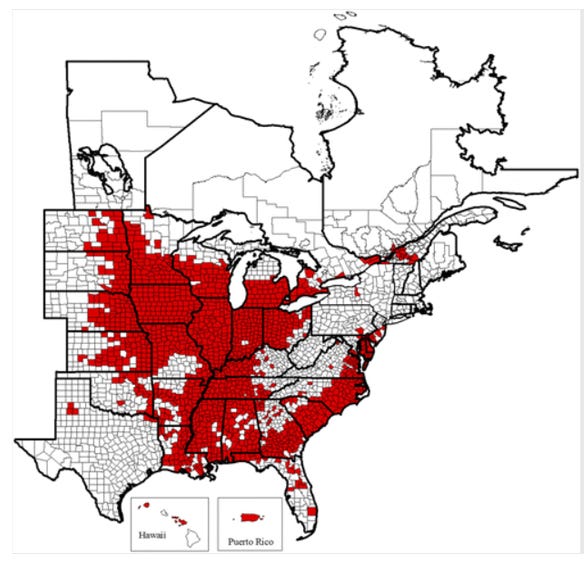November 14, 2019

Unfortunately for soybean growers, extremely wet weather in many states during 2019 didn’t drown or slow the spread of soybean cyst nematode. “It’s likely that floodwaters moved SCN to new areas,” says Greg Tylka, nematologist at Iowa State University and leader of The SCN Coalition. “That’s one reason we’re recommending soil sampling for SCN during fall soil fertility testing.”
It’s not just flooding that’s responsible for SCN’s expanding range. Soil moved by wind, birds and other animals and farm equipment have been spreading SCN in all directions since 1954, when it was first discovered in New Hanover County, N.C. The tiny wormlike pest works underground, attacking soybean roots and stealing yield.
“As of 2019, SCN has been confirmed in every county in Illinois and Iowa, and all but two Indiana counties [Monroe and Brown],” Tylka adds.
He’s been tracking the spread of SCN for almost 20 years. About once every three years, Tylka surveys nematologists, plant pathologists and agronomists from soybean-growing states and Canadian provinces to gather updated information on counties known to be infested with SCN.
Newly infested counties
In 2017, the last time he updated the SCN distribution map, it showed that the No. 1 soybean pathogen had spread to new counties in 17 states: Alabama, Georgia, Indiana, Iowa, Kansas, Kentucky, Minnesota, Missouri, Nebraska, New Jersey, New York, North Carolina, North Dakota, Ohio, South Dakota, Virginia and Wisconsin.

SCN KEEPS SPREADING: This map from Greg Tylka and Chris Marett at Iowa State University shows the counties in which SCN has been discovered between 1954 and 2017. The map will be updated in 2020.

Tylka will be polling his peers again later this year to update the map in 2020. Until then, here’s a list of the most recent counties and municipalities that have been confirmed as infested with SCN since 2017:
Simcoe County, Ontario
Rural municipalities of Emerson-Franklin, Montcalm, Rhineland and Norfolk Treherne in Manitoba
Gladwin County, Mich.
Franklin County, Pa.
Sanborn and Spink counties in South Dakota
He cautions that this is an incomplete list: “I don’t want to give the impression that these are all of the new SCN-infested counties. These are just the ones I’m aware of without having done a systematic survey of colleagues yet.”
Test soils, know numbers
“You can’t manage something that you don’t know you have,” Tylka says. “Management of SCN starts with sampling. You need to know what fields have it and at what levels. That sets the stage for how you’ll want to approach the battle.”
Rotating soybeans with non-host crops helps control this pest. “If you catch SCN numbers when they’re relatively low or moderate, it’s a fairly painless rotation to non-host crops like corn, oats, wheat, alfalfa or sunflower. Or as you get into the southern U.S., cotton and peanuts are non-hosts.”
“Then get to know more about the different types of SCN-resistant soybean varieties that are available, which ones are more effective than others and how to rotate them properly. We also have a new tool in seed treatments,” Tylka says. “The SCN Coalition recommends actively managing SCN with all four tools.”
A 45-second video of Tylka discussing SCN management is at YouTube. For more information about managing SCN in your state or province, visit thescncoalition.com.
Source: SCN Coalition, which is solely responsible for the information provided and is wholly owned by the source. Informa Business Media and all its subsidiaries are not responsible for any of the content contained in this information asset.
You May Also Like




